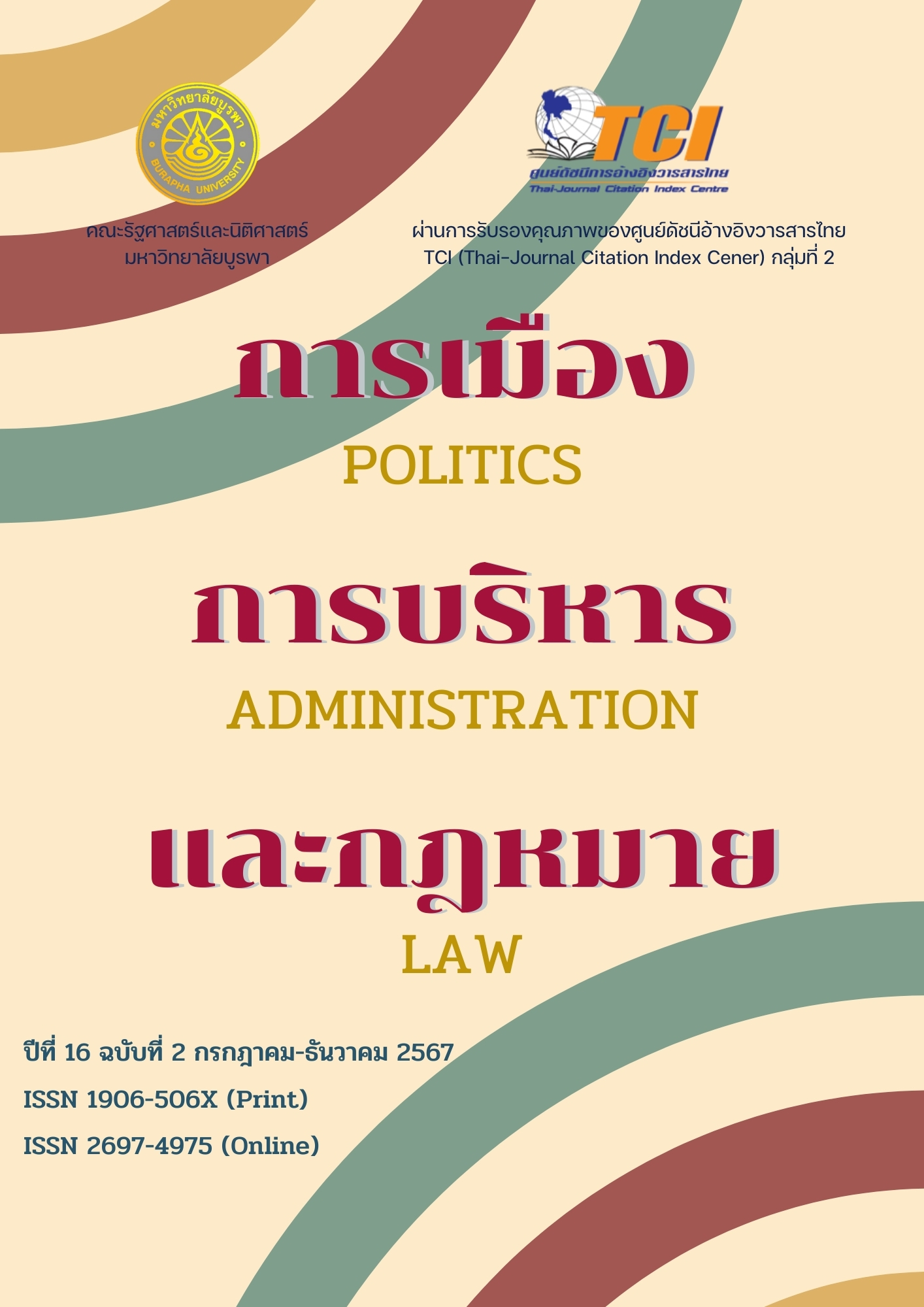ปัญหาทางด้านกฎหมายในสิทธิที่ดินทำกินของชนพื้นเมืองในประเทศไทย: ศึกษากรณีกะเหรี่ยงแก่งกระจาน
คำสำคัญ:
ชนพื้นเมือง, สิทธิในที่ดิน, สิทธิของประชาชนในการกำหนดเจตจำนงของตนเอง, ชาวกะเหรี่ยงบ้านใจแผ่นดินและบ้านบางกลอยบนบทคัดย่อ
การศึกษาปัญหาทางด้านกฎหมายในสิทธิที่ดินทำกินของชนพื้นเมืองในประเทศไทย: ศึกษากรณีกะเหรี่ยงแก่งกระจานมีวัตถุประสงค์บางประการเพื่อแสดงให้เห็นถึงมาตรการทางกฎหมายระหว่างประเทศและภายในประเทศที่มีอยู่ในการรับรองและคุ้มครองสถานะของชนพื้นเมือง โดยการศึกษานี้มุ่งเน้นในเรื่องการเข้าถึงสิทธิในที่ดินทำกินของกลุ่มชนพื้นเมืองชาวกะเหรี่ยงบ้านใจแผ่นดินและบ้านบางกลอยบนในเขตพื้นที่อุทยานแห่งชาติแก่งกระจาน ซึ่งการศึกษานี้เป็นการศึกษาวิจัยเชิงคุณภาพโดยใช้วิธีการค้นคว้าและรวบรวมข้อมูลจากเอกสารต่าง ๆ ที่สะท้อนให้เห็นถึงการส่งเสริมให้เกิดการมีส่วนร่วมและรับรองสิทธิของชนพื้นเมืองเพื่อนำมาเป็นแนวทางในการกำหนดมาตรการ หรือนโยบายในการปกป้องสิทธิของชนพื้นเมืองและส่งเสริมสิทธิการมีส่วนร่วมบนพื้นฐานสิทธิของประชาชนในการกำหนดเจตจำนงของตนเอง การส่งเสริมการมีส่วนร่วมของชนพื้นเมืองในกระบวนการตัดสินใจใด ๆ ที่ทำให้การกระทำของหน่วยงานภาครัฐมีความชอบธรรมในการดำเนินนโยบายและการดำเนินการทางกฎหมาย
ผลจากการศึกษาพบว่าชนพื้นเมืองที่อาศัยทำกินในเขตพื้นที่ป่าหรือเขตพื้นที่คุ้มครอง อนุรักษ์ สงวน หวงห้ามนั้นยังคงไม่ได้รับการรับรองสถานะทางกฎหมายอื่น ๆ ในประเทศเพื่อเข้ามามีส่วนร่วมในเรื่องต่าง ๆ และการมีสถานะตัวตนเป็นประชาชนในประเทศอันมีสิทธิเสรีภาพต่าง ๆ เท่าเทียมกับประชาชนอื่น ๆ ในประเทศโดยปราศจากการเลือกปฏิบัติอันเกิดจากอคติใด ๆ อันเป็นการยอมรับถึงการมีสถานะที่ เท่าเทียมกับประชาชนในประเทศโดยกลไกหรือกระบวนการต่าง ๆ จากทางภาครัฐอย่างเป็นรูปธรรม แม้ว่าสาระสำคัญของเนื้อหาในกฎหมายจะได้กำหนดว่ากลุ่มชนพื้นเมืองคือบุคคลที่ควรได้รับการรับรองสถานะทางกฎหมายและควรได้รับสิทธิในการเข้ามามีส่วนร่วมและสิทธิต่าง ๆ ที่เท่าเทียมกับประชาชนอื่น ๆ โดยปราศจากการเลือกปฏิบัติอันเกิดจากอคติใด ๆ หรือเหตุผลอื่นใด แต่ในทางปฏิบัตินั้นกลับพบว่ายังมีข้อจำกัดที่เกิดจากนโยบายหรือมาตรการต่าง ๆ ของทางภาครัฐที่ทำให้ชนพื้นเมืองถูกจำกัดสิทธิในการเข้าไปมีส่วนร่วมในการตัดสินใจในเรื่องต่าง ๆ รวมไปถึงเรื่องสิทธิในที่ดินทำกินได้อย่างเสรีโดยปราศจากการแทรกแซง อีกทั้งมาตรการทางกฎหมายหรือนโยบายต่าง ๆ ของทางภาครัฐที่มีความต้องการที่จะอนุรักษ์ทรัพยากรป่าไม้จึงทำให้ชนพื้นเมืองไม่สามารถเข้าไปอาศัยทำกินยังพื้นที่ที่ได้อาศัยทำกินดั้งเดิมมาตั้งแต่ครั้งบรรพบุรุษได้และยังมิได้มีการปักปันเขตแดนพื้นที่ให้แก่ชนพื้นเมืองนั้นทำให้เกิดปัญหาในเรื่องสิทธิในที่ดินของชนพื้นเมือง
เอกสารอ้างอิง
Aboriginal Land Rights (Northern Territory) Act 1976 (Cth) (ALRA) § 11 ,12.
Aboriginal Land Rights (Northern Territory) Act 1976 (Cth) (ALRA),§ 40, 41,41A,42 (1976).
ALRA § 3.
Musgrave, T. D. (1997). Self-determination and National Minorities, Great Clarendon Street, Oxford ox2 6DP: Oxford MonoGraphs in International.
NCIP. (2022). National Commission on Indigenous Peoples. Retrieved February 28, 2022, from https://ncip.gov.ph/programs/
OHCHR. (2020). Australia Government Submission to the UN Expert Mechanism on the Rights of Indigenous Peoples (EMRIP) study on efforts to achieve the ends of the Declaration on the Rights of Indigenous Peoples. Retrieved January 20, 2022, from https://www.ohchr.org/Documents/Issues/IPeoples/EMRIP/StudyRRR/Australia_submission_EMRIP_RRR.pdf
Quane, H. (2011). Reflections on the UN Declaration on the Rights of Indigenous Peoples (Stephen Allen & Alexandra Xanthaki Eds.). Oxford, Oxfordshire, UK: Hart Publishing Ltd.
Summers, J. (2019). The Right of Peoples to Self-Determination in article 1 of the Human Rights Covenantes as a Claimable Right. New England Journal of Public Policy, 31, 6.
The International Work Group for Indigenous Affairs (IWGIA). (2022). The Indigenous World 2022 (Dwayne Mamo Ed.). Denmark: Eks-Skolens Grafisk Design & Tryk.
ดาวน์โหลด
เผยแพร่แล้ว
ฉบับ
ประเภทบทความ
สัญญาอนุญาต

อนุญาตภายใต้เงื่อนไข Creative Commons Attribution-NonCommercial-NoDerivatives 4.0 International License.






